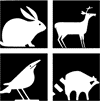Wildlife Damage Management, Internet Center for
Date of this Version
2005
Document Type
Article
Abstract
Density, morphometrics, and disease prevalence of raccoon populations were determined in 4 habitats (agriculture, riverine, managed, and forested) in central Alabama. In addition we monitored 71 collared raccoons to determine survival. Density estimates were similar in the agriculture (ag) and riverine habitats in central Alabama with 8 raccoons/km2, and lower in the forested habitat at 5 raccoons/ km2. Retention of juveniles did not appear to contribute to observed higher populations in the riverine and ag habitat. Although the riverine and ag, possibly due to supplemental resources, likely provide better habitat for raccoons, we found only body size in female raccoons to be different across habitats (P = 0.001). Human-caused mortality (either hunting or missing and presumed killed) was the main cause of mortality in several raccoon populations during fall; however, fall survival did not differ between the habitats (χ = 1.47, d.f. = 3, P = 0.69). Although rabies and distemper virus were prevalent in all habitats, they did not appear to contribute to mortality even with a high proportion of the population exhibiting positive CDV titers (ag – 44%, managed- 50%) and rabies titers (managed- 57% and riverine habitat-60%).



Comments
Published in Proceedings of the 11th Wildlife Damage Management Conference. (D.L. Nolte, K.A. Fagerstone, Eds). 2005.